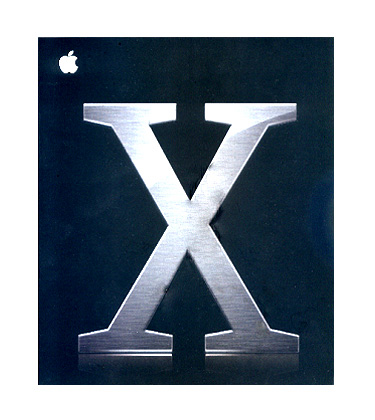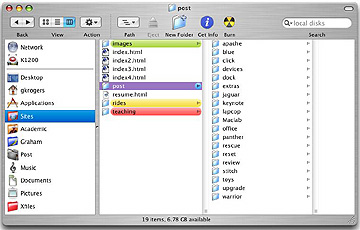eXtensions
By Graham K. Rogers

It is sometimes good to be proved wrong. I had anticipated that the 24 October release of OSX 10.3, Panther, would be delayed in Thailand, as it was for 10.2 (Jaguar). The logical release-date coincided with Digital World on November 8 - 10.
When I went into Phantip Plaza early on Saturday morning, there were shelves full of Panther boxes. I had my copy by 10.30 am. Allowing for World time-differences, we did well. The price was 5243 baht, or 4900 before taxes, which is actually cheaper than the US retail price if my calculations are correct.
I always get edgy -- and careful -- about upgrades. I removed all USB devices apart from keyboard and mouse. It is sensible also to remove the Firewire hard disk if you have one (and do not boot up with one plugged in). I checked my hard disk, backed-up data, and checked again. Just before installation, maintenance checks were run, I repaired permissions and ran a file/system check. This may be overkill, but I have been running problem-free since I first used OSX.
There were four disks in the package: installation, software, extra applications, and XCode Tools. The last two are only needed for programming or other specialist needs.
The first part of installation was reasonably quick. After a restart by the installer, the hard disk was checked. I did a straight-forward upgrade. There are other options including custom install and a total reinstall, which re-initialises the hard disk. The first part of the upgrade took about an hour. After a restart, disk 1 is ejected and I was asked for disk 2, which installs software. This part of the process was deadly slow because of the languages. By customising the install, I could have reduced both time and disk space taken. I removed these languages later using Delocaliser (from Versiontracker), which saved me about 700MB. Disk 2 was finally ejected and I was able to login.
Some installations of Disk 2 fail when there is confusion over iTunes or iMovie. With a custom install, the problem application can be deselected. Another way is to open the Library>Receipts folder and remove all references to the problem application.
There is a new login screen but all settings and data are conserved. Thai may have to be restarted in the Systems Preferences. Now, however, a user is able to view some of the system's settings (such as the menubar clock) in Thai.
 A noticeable change is in the Finder. Instead of Aqua, it now has a brushed metal look. It is certainly easier to navigate around the hard disk: forget how the previous Finder worked. Coloured labels have returned and items now open like spring-loaded folders. Some applications have new icons. Open windows in the Finder have administration tasks easily accessed.
A noticeable change is in the Finder. Instead of Aqua, it now has a brushed metal look. It is certainly easier to navigate around the hard disk: forget how the previous Finder worked. Coloured labels have returned and items now open like spring-loaded folders. Some applications have new icons. Open windows in the Finder have administration tasks easily accessed.
Certain preferences have undergone major changes, particularly Internet settings and there are added abilities to connect to Windows networks. Four major additions to Preferences are Exposé, Security, Print and Fax and fast user switching.
Exposé allows users to see small windows of all applications currently open. F9 makes all active programs appear evenly-spaced on the desktop: pass the cursor over a window and it is identified. F10 greys all but the front application; while F11 moves all widows to the side. Screen corners may also be used which allows fast switching between applications or files.
Security allows users to encrypt the home folder. There is a master- and a user password. Apple warns that losing the master password means the data "will be lost forever."
Like a number of the other changes, the ability to send faxes from the print menu was long overdue. Print Center has been replaced with a Printer Setup Utility. Printing a test page brought up an HP icon.
When I first saw images of Fast User Switching (accessed through the Accounts preferences), I was impressed. Users may want access to accounts for a couple of minutes only. Unfortunately, my iMac does not have high-end graphics: instead of the rotating cube, the screens just change. With the Cinema Display in my office, the effect works as advertised: indeed, in real life it looks better than the screen shots on the Apple web-site. The first switch requires that a second user log in, and there is a delay. Subsequently, a switch is made almost instantly. Using PPP options, the modem connection does not drop when users switch.
There was disappointment when Safari would not start. Many users had problems with this. In my case, I removed a folder with the name of SIMBL in the Library> Applications Support>Safari folder. This contained data needed for a kiosk addition to Safari. Once this was trashed, Safari worked perfectly. Before I upgraded the G4 to Panther, I dumped the SIMBL folder and Safari was fine.
After repairing permissions, the printer may stop working (mine was OK). A script fixing this was made available at http://www.allosx.com/. On my office G4 the IP printer disappeared after this process, but was reinstalled (the drivers come with OSX) with a couple of clicks. It is a good idea to note things like IP numbers before making changes.
Two days after its release Apple provided a security update to cover a problem (with Java and Quicktime) that could lead to an insecure system. Along with this was an iSync upgrade. Other upgrades may be available soon.
After several days all is well. The iMac has responded well to this new upgrade. Switching between applications is fast, and startup times have been reduced. Synchronisation between Palm, phone and iMac operate perfectly. There are apparently 150 additions or improvements and I am finding that some of these (I have not found them all yet: try the Apple key + Tab) are making work even easier than before.
Note:As an addition to the tip in the last paragraph, when you hold down the Apple (command) key and press Tab, a semi-transparent panel with icons of all open applications appears. Press the Tab key and the highlight moves from left to right. If you also press the Shift key, the highlight goes from right to left.
For further information, e-mail
to Graham K. Rogers.
Back to
eXtensions
Back to homepage
 A noticeable change is in the Finder. Instead of Aqua, it now has a brushed metal look. It is certainly easier to navigate around the hard disk: forget how the previous Finder worked. Coloured labels have returned and items now open like spring-loaded folders. Some applications have new icons. Open windows in the Finder have administration tasks easily accessed.
A noticeable change is in the Finder. Instead of Aqua, it now has a brushed metal look. It is certainly easier to navigate around the hard disk: forget how the previous Finder worked. Coloured labels have returned and items now open like spring-loaded folders. Some applications have new icons. Open windows in the Finder have administration tasks easily accessed.